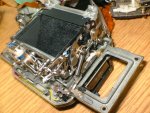Archive for the 'Uncategorized' Category
Posted in Geeking Out, Technology, Uncategorized on October 3rd, 2005
For those of you out there who enjoy listening to weird crap on the airwaves… you may note that E22 now uses “Bravo November 2″ as a call-up.
Let it be known that we here at Bravo November are most amused.
(We? Yeah… me, and my multiple personalities. Yes.)
How to go INSANE, in a few easy steps…
Posted in Geeking Out, Technology, Uncategorized on September 11th, 2005Or, “How to repair the mirror box squeak on a Canon AE-1″.
NOTE: This procedure is applicable to ALL Canon A-series cameras, however, each one differs. Be sure to get the service manual for the proper model before starting!
I regret not taking more photographs of this procedure… however, I do have another AE-1 around that could use it, so this post will probably be updated with more photos when I do it on that one.
Background: The Canon AE-1 was one of the most advanced cameras made, at the time when it came out. It was one of the first cameras to use digitally timed shutter speeds, replacing a whole pile of mechanical linkages with a ‘microprocessor’ timing circuit (more like a bunch of shift registers, if you ask me… but hey…) and electromagnets to control the shutter curtains.
Unfortunately, there’s one part in there that wasn’t lubricated with the most advanced lubricant available at the time… the mirror damper.
To reduce the ‘mirror slap’ which otherwise occurs when the mirror assembly is flicked up and down by the springs, Canon fitted a rotary damper, which works a bit like the governor on a music box. The last step of this mechanism is a small brass flywheel, which runs on a metal shaft. Over time, the lubricant on this shaft dries up and the wheel squeaks. It will initially just be a slight squeak, eventually, in severe cases, becoming a horrible squelch and finally throwing off the camera’s timing, or even jamming it completely!
There are instructions on the web for lubricating the mirror damper using a needle - I could not see ANY possible way this would work on the AE-1 Program I worked on!
Anyway, here’s my advice. If you’ve got the time and money to send the beast out for repair, do that.
If you don’t want to spend the money on the repair, or it absolutely must be working by tomorrow… set aside about four hours, a nice clear workbench, and a calm state of mind.
Tools required: Small Phillips screwdriver, soldering iron, synthetic lubricant, sewing pin/needle/small piece of wire, spanner wrench. The first three are available at Radio Shack; the fourth should just be lying around. The fifth is pretty exotic, but you can substitute the tips of a small pair of needle-nose pliers. If they aren’t small enough, you can use a grinder to reduce them to points.
Warning: If you’ve never soldered before, practice on a dead piece of gadgetry. The flex circuit boards in the AE-1 take VERY little heating to solder and desolder wires on, and WILL be damaged by excessive heat! It takes much less than 1 second to solder or desolder a wire connection on them.
First step: Get the appropriate service manual for your camera! For the AE-1 Program, the service manual is on this great page of information. (Thanks!) Put a battery in the camera and release the shutter, if it isn’t already.
Remove the camera back. On the AE-1, it comes off with a small latch at the hinge, as it was made to be user-interchangeable. Otherwise, just leave it on. Be careful not to hit the shutter curtains with your fingers or anything else!
Follow the service manual’s instructions to remove the top cover. On the AE-1 Program, the front fascia around the lens mount has to come off first, followed by all the gadgetry on the top of the camera. The wind lever has a strange nut on it that requires a spanner or pair of needle nose pliers to unscrew. The snap rings can be dealt with carefully with a small (jeweler’s-size) flat-blade screwdriver. Carefully peel off the leatherette on both sides. Lift up the top cover, desolder three wires to the flash shoe and PC connector, and you’re in. The bottom cover should be removed as well.
Then go through the service manual’s procedure to remove the mirror box. (I’m not going to try to describe it here.) You’ll be desoldering two more wires.
Finally, you’ll be able to remove the mirror box.

The small brass flywheel is the only thing you should lubricate. Apply a small amount of lubricant (I used the Teflon/silicone stuff that comes in the Radio Shack ‘precision lubricator’ tube) to the ends of that by sticking a droplet to a needle or pin, then transferring that to the shaft at the end of the flywheel.
Before putting the mirror box back in, make sure the large electromagnet on the bottom is in its released position, and that the mirror release tab is in the right place. Otherwise the camera will not wind correctly. Before reinstalling all the screws/wires/etc, hold the mirror box in place, put the cam and lever back on the wind shaft, and make sure it winds correctly. (The wind lever must lock at the end of the stroke.)
Finally, you’re done… in one easy for me to say step… put it all back together again, and enjoy!
Atencion! Tres, uno, cinco…
Posted in Art, Technology, Uncategorized on September 5th, 2005Most of us have used a radio reciever to listen to music, news, and entertainment programming. Worldwide, there are broadcasters keeping the airwaves alive 24 hours a day, and there’s almost never a lack of anything to listen to in the AM and FM broadcast bands.
Somewhere between, notably, in the area between 3 and 30 Mhz, there’s a strange parallel world of signals. In that band, known as shortwave or HF (High Frequency), the radio waves are reflected off the Earth’s surface and ionosphere, allowing them to sometimes travel all the way around the world.
Occasionally, a distant station will be heard with a strange echo as it is recieved first from a rather direct bounce off the ionosphere, followed by a bounce that went all the way around the globe!
As for the content of these signals, just about anything can be found on shortwave; news and music from your own country and others around the world, ham radio operators and captains of ships and aircraft speaking to each other, and any number of digital signals carrying everything from text to weather charts. Morse Code, still quite alive and well, continues to be used there worldwide.
Explore the world of shortwave radio long enough, though, and you will run into one of radio’s oldest mysteries. Among the static, ionospheric whistes, lightning crashes, man-made electrical noise, and other background radiation, voices, Morse code, and electronic tones send out mysterious messages consisting only of numbers.
There are any number of theories as to the intent, originator, and recipients of these messages, and quite a large number of different transmission formats which would suggest different organizations as their sources. Some of them are known to have been used to send encrypted messages to spies in the field, some may be messages destined for foreign embassies, and there are rumors that some are even used by drug smugglers and terrorists. The only thing that is certain is that only one organization knows the meaning of these messages, and they aren’t sharing.
A typical transmission from one of these stations consists of two parts; a preamble, and a message. The preamble is a call-up with a distinctive sound and content, intended to allow the station’s recipient to easily find the signal by ear. This is necessary as the station may need to change frequency due to interference or jamming, or the recipient in the field may be limited to using very simple and inconspicuous radio equipment that doesn’t have a well calibrated tuning indicator.
These call-up sequences are quite intentionally unique, and are sometimes very interesting. Musical sequences, repeated call signs in voice or Morse code, and electronic tones have all been used by various stations. Listeners worldwide have heard everything from repeated callsigns or simple beeps to musical pieces by Jean-Michel Jarre preceding messages.
One of the most well remembered of these would come on the air with a snake charmer-like flute melody, to which a voice repeated the words “Papa November”, over and over. Well, in case you were wondering what inspired the odd title of this site, there you go…
A couple of stations even have interval signals that run continuously. One, known as ‘The Squeaky Wheel’, sent a squeaking set of tones every few seconds for several years before pausing temporarily for a voice to read out numbers. Other similarly repetitive beeps or ticks may be similar operations.
The messages themselves are generally numbers grouped into blocks of 5 digits, which are deciphered using either a written code book or by computer software. The means by which they are sent varies by the station; some use synthesized or recorded and replayed voices, some use manually or automatically sent Morse code, and some use digital codes. One of the creepiest sounding stations uses an electronic polytone system, in which a tone is assigned to each number from 0 to 9, and they are sent sequentially at about 3 digits per second.
Much has been speculated, observed, and written about these stations, but the only way to experience the truly mysterious, magical, and downright chillingly creepy phenomenon that they are is to listen in. These stations are located all over the world, and there may even be some practically right in your backyard. I’ve actually found a few in my hometown of Miami!
Here are some links for further information:
The Enigma 2000 group, dedicated to the study and observation of these strange creatures.
Spynumbers.com, with some information and schedules
Stations that may be on the air now, or in the next hour
Simon Mason’s site
A recording of a Cuban numbers station. This one’s rather famous for its poor transmission quality and technical glitches. Birds have even been heard squawking over the woman reading numbers over the horrendous AC hum over the Morse code leaking in from another transmission over the Morse code leaking in from yet another transmission. (*phew*)
The bling invasion scores another stronghold
Posted in Imagery, Uncategorized on July 13th, 2005I just spotted here, in the university center at FIU, a bling-equipped electric wheelchair.
It had short red neon tubes underneath providing underbody lighting, chrome spinner rims, and the silliest part of all? It had those skate wheels with the little magneto/color LED hubs and clear rubber surround for the small rollers at the back that prevent it from tipping backwards when running over curb cuts. It kinda reminded me, perhaps, of Craig Johnson’s wheels, but with less “cool” and more “oh dear gods that is WRONG”.
Like any such modifications, these were aesthetic only. The chair could still just barely make 2 mph.
And it is moments like these, OF COURSE, when I find my excellent Spotmatic II out of film with no spare roll handy to document the pure WEIRD.
Le sigh.
Version two point fish.
Posted in Uncategorized on April 6th, 2005Now, there shall be… MADNESS!
The original version of this site with its tiny bit of content will remain over here for convenient viewing. This, however, is the next generation of automagically updating fun.
Let the madness begin.
